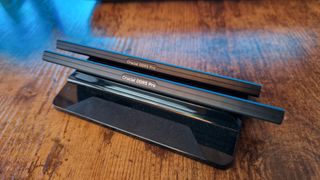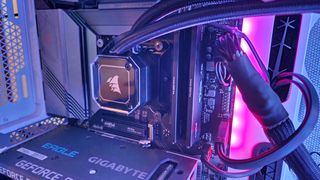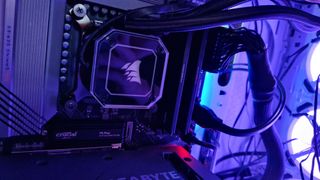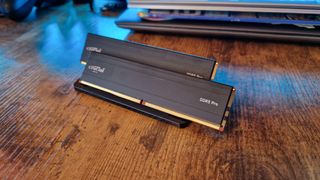12DOVE Verdict
Sometimes less is more, and sometimes, less is just okay. Crucial DDR5 Pro RAM enters the very competitive field of current gen memory and doesn't do an awful lot to stand out from the crowd. Depending on you, your budget, and what you're looking for in your memory, that could be a great thing or leave you wanting more.
Pros
- +
Consistent with other DDR5
- +
Reasonably priced
- +
No nonsense RAM
- +
2 XMP profiles on board
Cons
- -
Basic design
- -
No overclocking capability
- -
Just as demanding as better, faster DDR5
Why you can trust 12DOVE
Crucial DDR5 Pro RAM doesn't have time for your RGB lust. It doesn't care about that overclocking video you watched on YouTube, and it's not going to pretend that it's anything more than it is. As someone who reviews RAM, I hate to admit that it's probably the most boring of all the PC components. DDR5 manufacturers have tried to bury that secret under a slew of enticing features as they try to ensnare people into upgrading, but it's nonetheless true.
Crucial's best RAM for gaming almost leans into that though - it's plain, it's simple, and it's the kind of RAM your dad might like the look of. But when there's very little separating one memory kit from the next, is a less-is-more approach really the tactic to choose?
You'd at least hope that this strategy would involve a more affordable price tag, but at $120 / £120, Crucial DDR5 Pro exists in the same arena as a lot of gaming-specific competitors. Even if Crucial's prices dip early and dip often, and you can find this 32GB (2x 16GB) kit for $100 / £100, you're still up against the best of the best.
Design and Features

In a lot of ways, Crucial DDR5 Pro RAM reminds me of our PNY XLR8 MAKO DDR5 review, because its design is so scaled back. If anything, Crucial's sticks are even more bare-bones since they don't even have some flashy shark fins on their heatsinks to help jazz them up. What you see is what you get here, there's a black chassis covering the sticks themselves, and some fairly subdued branding that won't make itself known inside one of the best gaming PCs.
Thankfully, these still feel substantial enough that I wasn't at all worried about snapping them during installation. When I first tried to seat Sabrent's Rocket DDR5 RAM, which is our favorite memory for overclocking, the sticks seemed so thin I was genuinely a bit worried. I felt I could click these Crucial sticks into place with no bother at all though.
The heat spreader Crucial has designed is made of aluminium, and I found that while it dissipated heat fairly well across the modules, the sticks were still warmer to the touch than with some more flashy RGB RAM I've tested.

As far as physical design, there really isn't much more to say. There's no RGB lighting, there's no B/E-die, and there are no dedicated design decisions to help with overclocking. These sticks have two XMP profiles on board, along with one AMD Expo profile, and that's pretty much as exciting as they get. These sticks are available in kits of 8, 16, 24, 32, and 48GB, and in speeds of 4800, 5200, and 5600MT/s. Keep in mind that MT/s isn't the same as MHz, but I tested 32GB of 5600MT/s for this review.
Even when it comes to features, we really don't have much to discuss. I could get into the weeds of unbuffered DIMMS, the 16GB Die Density, and the fact that Crucial uses Micron's own D8DDZ chips. The latter is a welcome change from the usual SK Hynix or Samsung chips found in a lot of gaming RAM today. Nevertheless, Crucial clearly doesn't want my design and features section to be long, so we'll cut straight to performance since I've already covered what you need to know.
Performance

As someone who loves overclocking RAM to test it for these reviews, I am a bit disappointed with Crucial's DDR5 Pro kit. It feels a bit like I'm a bungee jumping instructor, and Crucial's DDR5 Pro is that one person in the group who signed up even though they hate heights and were realistically never going to take the leap anyway.
To review DDR5 RAM, I usually install it into our testing PC, pair it with an i7 CPU and an RTX 3050 GPU, and play around with XMP profiles and different speeds to see how it performs when I'm gaming. For the last few reviews, 6000MHz has been the main testing speed, since most DDR5 kits aimed at gaming will sit around that mark, or at least overclock to it comfortably. As hard as I tried, I couldn't get the PC to post and successfully retrain this RAM above the 5000MHz mark.
Now, this isn't bad, by any means. You're still getting significantly faster speeds than DDR4, and a lot of starter DDR5 kits that offer 4800MHz on the box. The RAM I use in my own personal machine is that aforementioned Sabrent Rocket DDR5 kit, and that's advertised at 4800MHz. The difference is that Sabrent's sticks overclock way, way higher than that, and can comfortably sit above 4800MHz. When other DDR5 makes overclocking a main selling point, it's a bit of a disappointment when Crucial shows no interest yet charges the same kind of price.

Advertised JDEC timings are 46-45-45, but CPUZ gave me 36-36-36-76, with voltages of 1.10v. Again, these are nothing to get overly excited about - they're probably the average readings I see from DDR5 tests. Again though, when other RAM offers more for these types of demands and can give you more stability, it doesn't make Crucial very appealing.
Here at 12DOVE, we test RAM for the purpose of gaming, so we like to examine how each kit performs in three specific benchmarking games. With an entry-level 1080p graphics card, we've found cranking up speeds and playing around with XMP profiles can actually have impacts on the stability of frame rates, sometimes even offering advantages when running at 1440p. Our testing rig houses an Intel Core i7 13700K CPU currently, as well as a Gigabyte RTX 3050, and a PNY CS1030 SSD, all on a Gigabyte Z690 Gaming X motherboard. Here's how Crucial's DDR5 Pro got on running at 5000MHz.
| Game | 1080p | 1440p |
|---|---|---|
| Hunt: Showdown | 144fps | 96fps |
| Apex Legends | 160fps | 116fps |
| Control | 90fps | 53fps |
For all its lack of features and fun, Crucial's DDR5 Pro did manage to turn out some decent frame rates for operating at this speed. We tested Sabrent's Rocket DDR5 and PNY's XLR8 Mako DDR5 at 5000MHz, albeit with the previous generation of i7 processor, and Crucial managed to turn in very similar results.
Perhaps most noticeably, Hunt Showdown seemed to hit some sort of sweet spot with this RAM and this speed at 1080p - since it managed to clock significantly higher frame rates at full HD than it has in our last few RAM tests. The other numbers across the board are much of a likeness to other kits operating closer to 6000MHz, so that's a solid result at least.

What I will say, is that those frame rates did fluctuate more with this RAM than with the likes of Klevv Cras XR5 RGB DDR5, which is our current favorite RAM recommendation.
Overall, this is a solid RAM performer, but one that we'd recommend more to gamers rocking an i5/Ryzen 5 CPU than someone looking to pair it with a flagship processor and overclock it for all its worth. It is particularly disappointing that boosting speeds isn't an option here.
Should you buy Crucial DDR5 Pro RAM?

If you're someone who doesn't care about overclocking, wants simplicity, and is putting together a 1080p gaming PC, Crucial's DDR5 Pro RAM may be a solid choice for you. Particularly if you have a case without a transparent panel and you don't care about showing off beautiful RGB lights inside, this is a match made in heaven.
If you want the truest benefits of what DDR5 gaming RAM can offer, maybe think again. For starters, some RGB can make your PC shine, but even putting looks to one side, there are genuinely beneficial overclocking features and design choices that'll give you more bang for your buck.
Sometimes, less is more, and for people who want no-fuss RAM, I'm sure Crucial is appealing. For the money you're paying here though, is less really more? I for one think people wanting to squeeze every last drop of performance out of their PCs can do better.
How we tested Crucial DDR5 Pro RAM
I put Crucial's Pro DDR5 RAM to the test inside our testing PC and got a feel for how it performed in general productivity tasks. It worked just as smoothly as any other DDR5 RAM I've reviewed in that regard. For gaming, I played three specific games at 1080p and 1440p with an entry-level GPU to see how it could help take the strain away from other components, particularly when the GPU was working to capacity. I also played around with speed settings in the BIOS menu and examined to what extent the RAM's XMP profiles made a difference. Lastly, I used CPUZ to track the finer numbers of voltages and readings.
For more on how we test the latest PC components, check out our hardware policy.
Looking for more PC upgrades? Take a look at the best CPU for gaming, the best graphics cards, and the best computer speakers.
One of my earliest memories is playing SuperMario64 and wondering why the controller I held had three grips, but I only had two hands. Ever since I've been in love with video games and their technology. After graduating from Edinburgh Napier University with a degree in Journalism, I contributed to the Scottish Games Network and completed an Editorial Internship at Expert Reviews. Over the last decade, I’ve been managing my own YouTube channel about my love of games too. These days, I'm one of the resident hardware nerds at 12DOVE, and I take the lead on our coverage of gaming PCs, VR, controllers, gaming chairs, and content creation gear. Now, I better stop myself here before I get talking about my favourite games like HUNT: Showdown, Dishonored, and Towerfall Ascension. Location: UK Remote

Monster Hunter Wilds looks slightly less terrifying for PC gamers: Capcom has reduced system requirements and released a 26GB benchmark tool ahead of the second beta

The Sims design mastermind Will Wright says the first Sims ever made were "too good" at staying alive and needed to be stupider for the game to be fun

Steam now warns you if an early access game hasn't been updated in a long time, but outside obvious abandonware, it's not clear what actually counts as an update

